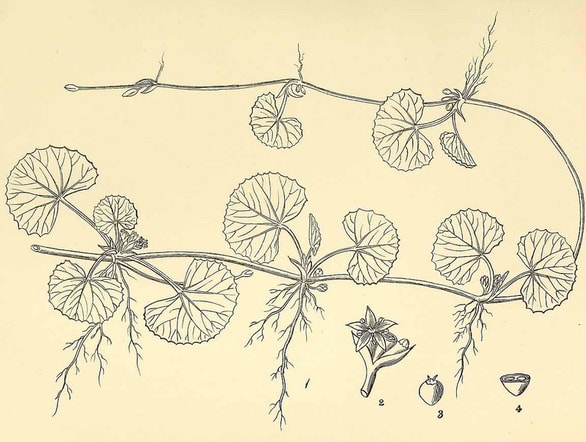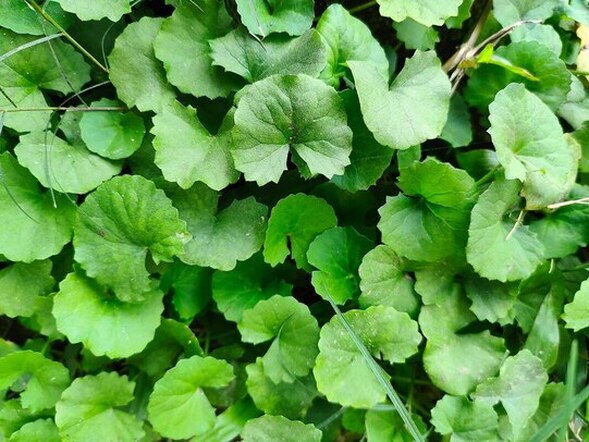Centella, Pennywort, Ji Xue Cao 积雪草
Indian Pennywort, Gotu Kola
Brahmi, Mandukaparni (Ayurveda)
Ji Xue Cao (TCM)
Brahmi, Mandukaparni (Ayurveda)
Ji Xue Cao (TCM)
Kirtikar, Basu, Indian medicinal plants, Plates, 1918
Botanical name:
Centella asiatica (syn. Hydrocotyle asciatica)
The European C. vulgaris has been used similarly.
In India, Brahmi also encompasses Bacopa monieri
Parts used:
Herb
Temperature & Taste:
Cold, dry. Pungent, Sweet
Classifications:
4j. NERVINES
B. Clear Heat N. Tonics
Centella asiatica (syn. Hydrocotyle asciatica)
The European C. vulgaris has been used similarly.
In India, Brahmi also encompasses Bacopa monieri
Parts used:
Herb
Temperature & Taste:
Cold, dry. Pungent, Sweet
Classifications:
4j. NERVINES
B. Clear Heat N. Tonics
ADVERTISEMENT:
Uses:
1. Clears Heat and Damp (Ayurveda, TCM):
-Diarrhea, Dysentery
-Jaundice (Chinese Pharmacopoeia)
-Strangury, Urinary Tract Infection, Cystitis, Hematuria
2. Clears Toxin, Disperses Toxin (Ayurveda, TCM):
-Fever, High Fever, Eruptive Fevers
-Acute Sore Throat, Laryngitis, Tonsillitis
-Infectious Diseases
3. Clear Heat and Phlegm, Stops Cough:
-Cough, Wheezing, Asthma
-has been used for Tuberculosis
4. Clears Heat, Stops Bleeding:
-heat-type bleeding of the Nose, Bladder, Lungs, Stomach or Bowels
5. Clears Heat, Moves the Blood, Resolves Swellings:
-Toxic Swellings and Tumors, including Cancer.
-internally and topically for bruising following Trauma. (Chinese Pharmacopoeia)
6. Nourish the Kidneys and Liver, Benefits the Brain:
-powerful tonic in Ayurveda.
-promotes Intellect and Wisdom, increase Memory, prevent Senility, and promote Longevity.
7. Externally:
-skin diseases including Scabies, Leprosy
-Ulcers, old and stubborn Wounds etc.
-Applied to scarring, including post-operative scarring
Dose:
Decoction: 15–30 grams dry; 30–60 grams fresh
Correctives:
... available in PRO version
Substitute:
... available in PRO version
Decoction: 15–30 grams dry; 30–60 grams fresh
Correctives:
... available in PRO version
Substitute:
... available in PRO version
Main Combinations:
1. Fever, Centella with ... available in PRO version
2. Benefit the Mind, improve Memory:
i. Centella with ... available in PRO version
ii. Centella, ... available in PRO version
3. Calm the Mind and Nerves in anxiety, nervousness:
i. Centella with ... available in PRO version
ii. Centella with ... available in PRO version
iii. Centella with ... available in PRO version
iv. Centella with ... available in PRO version
v. Centella with ... available in PRO version
vi. Centella with ... available in PRO version
vii. Centella, ... available in PRO version
4. Nervous disorders:
i. Centella with ... available in PRO version
ii. Centella with ... available in PRO version
iii. Nervous debility, Centella with ... available in PRO version
5. Spasms:
i. Centella with ... available in PRO version
6. Epilepsy:
i. Centella with ... available in PRO version
ii. Centella with ... available in PRO version
7. Mental disorders, Insanity:
i. Centella with ... available in PRO version
ii. Centella with ... available in PRO version
iii. Centella with ... available in PRO version
iv. Mental disorders from Wind-Heat, Centella with ... available in PRO version
iv. Centella, ... available in PRO version
8. Skin Inflammation and Blood diseases:
i. Centella with ... available in PRO version
ii. Centella with ... available in PRO version
iii. Centella with ... available in PRO version
iv. Centella with ... available in PRO version
v. Centella with ... available in PRO version
9. Arthritic diseases, Joint inflammation:
i. Centella with ... available in PRO version
10. Cough, Consumption, Centella with ... available in PRO version
11. Diarrhea and Dysentery in children, Centella with ... available in PRO version
12. Strangury from Damp-Heat, Centella with ... available in PRO version
ADVERTISEMENT:
Cautions:
Generally Safe.
Main Preparations used:
Generally Safe.
Main Preparations used:
Click the Tabs above for more information on this Medicine
|
'In Sanskrit works this plant is called Mandukaparni, and is described as a useful alterative and tonic in diseases of the skin, nervous system, and blood. Chakradatta directs the fresh juice to be given with milk and liquorice. The plant was known to Rheede by its Malayalim name of Codogam or Kutakan, and also to Rumphius. Ainslie informs us that an infusion of the toasted leaves in conjunction with fenugreek is given to children suffering from bowel complaints and fever in doses of half a teacupful, also that the leaves on the Coromandel Coast are applied to parts that have suffered from blows and bruises, having, it is supposed, the power of keeping off inflammation. In Java, according to Horsfield, they are considered diuretic, and on the Malabar Coast the plant is one of the remedies for leprosy. As a remedy in this disease it was first brought prominently to notice by Lupine (1853) and Boileau. Dr. A.. Hunter, who tried it in the Madras Leper Hospital (1855), came to the conclusion that it had no claim to consideration as a specific in leprosy, but he found it most useful in
|
ameliorating the symptoms and improving the general health. In the Pharmacopoeia of India it has been made official, and is described as an alterative, tonic and local stimulant, more especially useful in syphilitic skin diseases, in which it may be used both as an internal and local remedy. Directions for making a powder and poultice are given. Recent reports from Europe (1885) confirm this statement, and there has been some enquiry for the drug in Bombay which has led to its cultivation on a small scale. In the neighbourhood of Bombay the plant is rare in a wild state, but may often be seen in gardens; it is a popular remedy for the slight dysenteric derangements of the bowels to which children are subject; 3 to 4 leaves are given with cummin and sugar, and the pounded leaves are applied to the navel. In the Concan one or two leaves are given every morning to cure stuttering; and the juice is applied to skin eruptions supposed to arise from heat of blood'. (Vegetable Materia Medica of Western India, Dymock, 1885)
|




